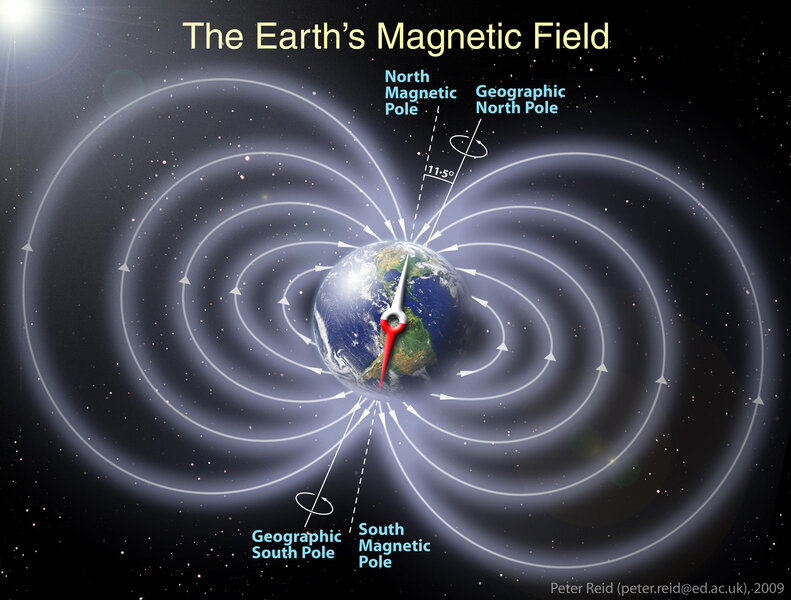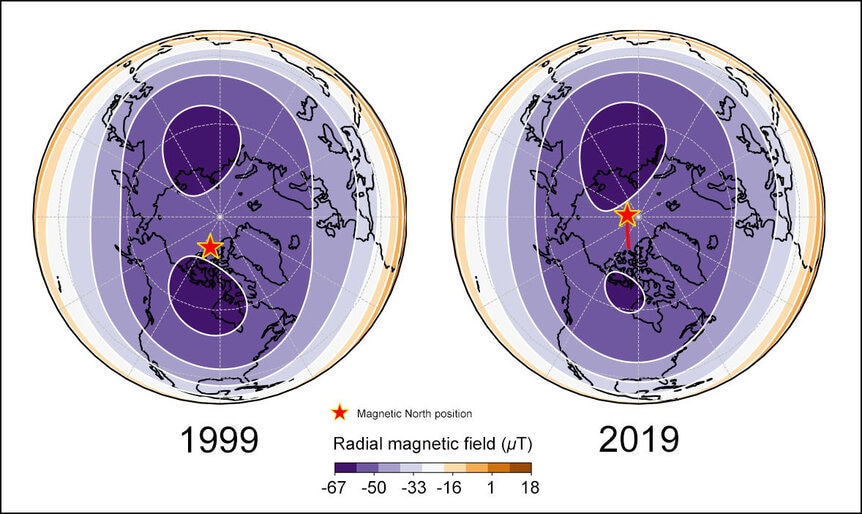Create a free profile to get unlimited access to exclusive videos, sweepstakes, and more!
Two huge blobs in Earth’s mantle are fighting it out over our magnetic pole

If you have a very sensitive compass, a predilection for graphing, and a lot of patience, you may have noticed that the Earth's magnetic pole has been hightailing it toward Siberia recently. It wanders all the time, actually, but in 1990 suddenly accelerated rapidly toward Siberia. A few fringe folks (as they are wont to do) have predicted doom and gloom over this, but in fact it's a natural and geologically common event… and scientists now think they know why.
The Earth is like a giant bar magnet, with a donut-shaped field that has a north and south magnetic pole (not to be confused with Earth's geographic poles, where its spin axis intersects the surface in the Arctic and Antarctic). The field is generated deep inside the Earth, in the outer core. The inner core is solid iron, but the outer core, where pressures are lower, is liquid metal, so the iron flows.
When it flows it generates an electric current. The Earth's rotation sweeps this around in a circle, creating a stable magnetic field. Well, relatively stable: The flow in the core isn't smooth, so that changes the field, and also the Earth's mantle (the hot rock above the core and below the crust) also affects the field generated, too. Blobs of material in the mantle can interact with the magnetic field, altering it.
The magnetic pole is defined as where the magnetic field is perpendicular to the Earth's surface. Because the Earth's spin in part powers this, the magnetic poles are near the geographic ones. The north pole was first measured in 1831 using compasses, but this is a pretty difficult thing to do, especially if it happens to be over water (plus the way the Earth's upper atmosphere interacts with the magnetic field can affect compasses too; it's a mess).
Nowadays we do this by using satellites. For example, ESA's Swarm satellites measure the local components of the magnetic field above the Earth, and these are used as inputs into a physical model of the magnetic field. From there, the pole's position can be measured pretty accurately.
From about 1840 to 1990, the north magnetic pole wandered over northern Canada, moving at a rate of up to 15 kilometers per year. But then, in 1990, it suddenly accelerated, topping out at 60 km/year! It's been making a beeline for Siberia, passing about 390 kilometers south of the geographic pole and crossing the International Date Line in October 2017.
Scientists found that there are two huge blobs of material deep within the mantle near the core/mantle boundary. One is under Canada, the other under Siberia. These blobs each create a bump in the magnetic field with a trough between them, like two mountains with a saddle pass, with the magnetic pole situated in that trough. As they slowly strengthen and weaken, the pole moves between them.
But in 1990 things changed. Scientists think a flow of material in the mantle deep under North America moved around the Canada blob, altering its shape, elongating it radially (that is, stretching it up toward the crust and down toward the core). This weakened its affect on the surface quite a bit. That gave the Siberian blob the upper hand, and the pole started shifting much more rapidly in that direction.
What does this mean? Well, for example for us it means scientists have to update magnetic maps a lot more often, since many phones use this info for navigation. As for people freaking out that it means the Earth's magnetic field is about to collapse or flip over, that seems unlikely. This sudden movement has happened before historically a couple of times in the past 7000 years or so, but the last flip in the magnetic field was 800,000 years ago, so it's safe to assume they aren't directly related.
Models of the magnetic field indicate it's liable to keep moving toward Siberia, probably another 390 to 660 km. After that it's hard to say; the models aren't reliable more than a few decades in the future. But over the past 7000 years it's wandered all over that area, and hasn't moved too far away from the geographic pole. It's just as likely to turn around and head back to Canada after that, since the movement is fairly sensitive to changes down there at the core/mantle boundary.
Short of getting Aaron Eckhart and Stanley Tucci to detonate nukes down there, there's not much we can do anyway. Happily, we need not worry, this is just the Earth doing what the Earth does. It's been doing this for 4.55 billion years, give or take, and I figure we have things on the surface to worry about more anyway.





























